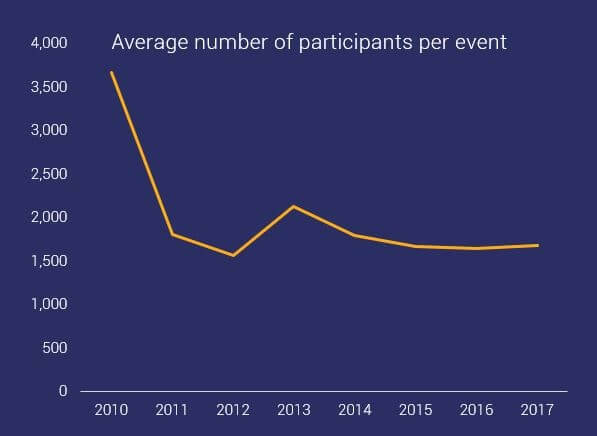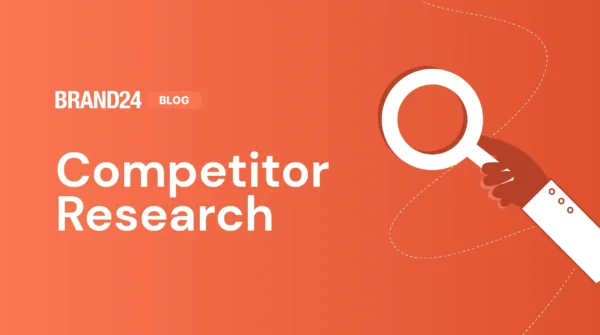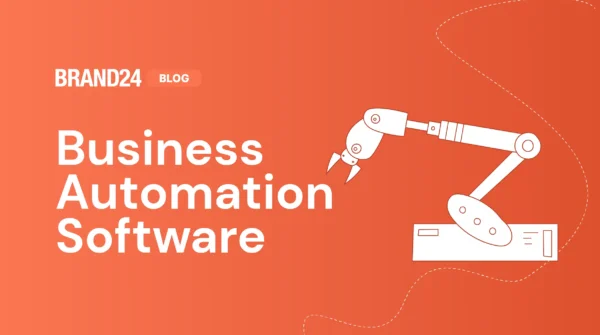How the OCR Race (Obstacle Course Racing) Went Mainstream: Thank You, Social Media
Obstacle course racing (OCR) is an interesting concept. People all around the world are paying to sweat, even at the risk of personal injury, pain and severe discomfort – all in the name of fitness! (Actually, injury might be more of a guarantee than a risk…)
So how did sufferfests become so popular – and how popular are we talking?
Recent growth and popularity of obstacle racing events
According to research from RunRepeat, OCR events have grown from less than 100,000 yearly participants to roughly 500,000! All in just 5 years between 2010 – 2015.

After 2015, we start to see signs of market saturation with a steady number of participants each year.
Looking at the average number of participants for each OCR event during the same period, we see a pattern of decrease.

This makes perfect sense: more events to choose from means less participants at each event (can’t run them all!). After 2015, the number of participants per OCR event is stable.
What draws people to these obstacle course racing events?
Besides seeing all kinds of inspiring posts about the awesome races that your friends just ran (or crawled and bled through) in your feed, look at all that each OCR race has to offer:
- Push physical and mental limits ♥
- Meet new people ♥
- Overcome challenging situations ♥
- Get dirty (without funny side glances from strangers) ♥
- Improve fitness ♥
- More affordable than a big trip ♥
- Lifetime bragging rights ♥
As far as events go, it’s pretty well-rounded, and for many who’ve participated, it’s addictive. Can you name anything more satisfying than the thrill of success and accomplishment?
But let’s not kid ourselves: an OCR race is not for the weak-willed. If you want lifetime bragging rights, you have to earn them. The hard way.
In case you’re wondering or have never participated before, these events are tough. For an OCR race like the Reebok Spartan Race, the completion rate is typically less than 25%.
Depending on your fitness level and the particular race itself, each event can be a competition between participants or, more than likely, a race against time.
Crunch, slosh, slide, electrocution… <25% completion rate. But don’t psyche yourself out. You’ll run yourself ragged and you need all the energy you can get.
Just how did OCR obstacle course racing become mainstream?
The answer is simple: social media.
Would people still want to participate in an OCR race if they weren’t so visible on social media?
I’m sure the answer is YES – though much less people would be aware of them.
Would OCR obstacle course racing be so popular without the rapid influx of awesome user-generated content that comes with every OCR race?
I’m sure the answer is NO because, well, nobody would know about them.
If you’re organizing or are in charge of marketing an OCR race, then monitoring and promoting your event on social media is key. Stay ahead of the game with social listening and monitor posts and conversations about OCR events all over the Internet.
Why track conversations about OCR races online and in social media?
There are many reasons, but it basically boils down to staying informed. Keeping track of relevant conversations online and where they occur tell you who is interested in obstacle course racing (so you can find your target audience). Know where people discuss and look for information about OCR events reveals where you need to distribute content and promote your OCR events.
Once you collect information – which is easy with the help of social media monitoring tools like Brand24 – it’s just a matter of filtering data according to the type of information needed.
It’s simpler than it sounds, especially if you think about separating different types of information as follows.
If you’re an OCR race organizer / promoter:
1. Feature your participants and engage with them
Bonefrog is a Navy SEAL owned and operated OCR race. And as you can see, featured participants appreciate receiving recognition for all the hard work that they put into completing a strenuous OCR race like this.
Organizers must remember that while each OCR race may be just 1 of their many seasonal events, it might be the first OCR race for any given participant. And each individual experience will determine whether a participant will return next season or encourage others to sign up.
The OCR World Championships is one of the highest-level global events for the general sport of OCR obstacle course racing. Participants need to qualify to enter, which usually means finishing among the ranks of the top 5-20 in any designated OCR race.
Many will try, most won’t make it, and those who do… well, they’ve earned the right to boast (see palms above). Oh, and the medals are nice, too.
2. Find sponsors and cross promotion opportunities
The Ironman Triathlon is more of a distance-based race than an OCR race, but they’re not without their similarities.
For instance, both present perfect opportunities for athletic brands to find brand ambassadors and collaborate with event organizers to simultaneously promote an event while featuring their products.
Inspiring photos like the one above showcase this beautifully. Seriously, when you’re fit, you’re fit.
3. Improve the experience for your participants
Tracking conversations related to your event via social media monitoring is an ideal way to get candid feedback about your event.
The participant above had a great experience at Warrior Dash, but wishes that timing chips could be provided to help participants track their completion time more accurately. Maybe at your next OCR race, Warrior Dash?
If you’re in an industry related to (or even not related to ) OCR obstacle course racing:
1. Join the conversation and recommend your product
Businesses in related industries can certainly benefit from tapping into OCR race conversations and engaging with potential customers.
Posts like the one above from a Savage Race participant are aplenty. OCR race participants wear out their equipment fast and are often on the lookout for product recommendations.
This conversation shows other participants openly making recommendations for their favorite products. This is a prime opportunity for the mentioned brands to 1) thank their customers for recommending their product and 2) engage with a potential new customer.
2. Find brand ambassadors
This Shale Hill participant can’t stop raving about her favorite shoes. One of the comments on the image indicate that her very vocal appreciation for the footwear brand even inspired a purchase (or 50)!
Hmm… now, tell me again: where could one possibly find any proud supporters and ambassadors of their brand… ? Thank you, social media monitoring.
3. Collaborate with OCR race organizers to create event-related products
If you participate in OCR obstacle course racing or similar athletic events, chances are you’ve heard of the Ragnar Relay.
They’re known for distance, team, and overnight relays… as well as their “van tagging” ritual (placing team magnets on other vans during races). Originally designed for teams as souvenirs, van tagging has become nearly synonymous with the race itself.
Whether you’re an OCR race organizer / promoter or if you work in an industry with matching interests, the data that you gather from social media monitoring can provide you with significant value.
Let’s review.
By monitoring & tracking relevant conversations via social media monitoring, you can:
- engage with your supporters
- find event sponsors
- learn how to improve the overall experience for participants
- find opportunities to recommend your product
- discover potential brand ambassadors
- get ideas for creating event-related products.
And that’s not all. There’s a lot more you can do with social media monitoring data; this list is far from conclusive. It just depends on what your goals are.
Curious about what to track? Here are 8 types of keywords you should be monitoring on social media all the time anyway.
Make sure your OCR race is a success by tracking relevant mentions and conversations with social media monitoring
Well, it’s official, the weekend will be here in just a few hours, so you know what that means… if you helped to organize or promote an OCR race (or maybe you’re racing), GOOD LUCK!!! Wishing you mild weather, a good turn-out, and if you’re competing – the shortest completion time of your OCR race career!
Event creators and promoters, don’t forget to check out Brand24 for social media monitoring. Set up your free projects now to uncover some amazing user-generated content and find out what your participants love about your OCR race!


![The 13 Best Market Research Tools to Use [2024]](https://brand24.com/blog/app/uploads/2024/07/market-research-tools-600x335.webp)


![Forums Monitoring: is it worth it in 2024? [Reddit and other forums]](https://brand24.com/blog/app/uploads/2024/06/forums_monitoring-600x335.png)